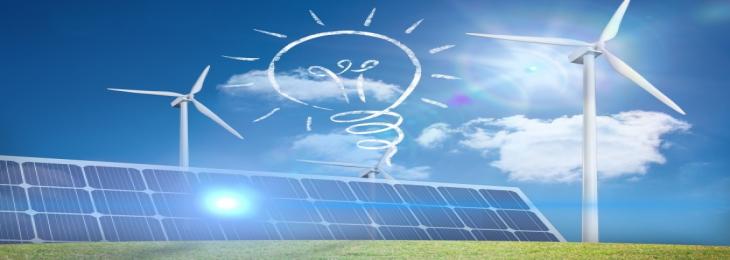
The Ministry of New and Renewable Energy (MNRE) has set an ambitious target to set up renewable energy capacities to the tune of 225 GW by 2022, of which, around 114 GW is planned for solar, 67 GW for wind and the remaining for hydro and bioenergy.
India is expected to play a crucial role in the future of the global energy market, as the country has a population of 1.4 billion and it is one of the world's fastest-growing economies.
According InvestIndia, in 2019, India was ranked as the fourth most attractive renewable energy market in the world. Furthermore, according to the same source, in 2018, India had the 5th largest installed capacity of renewable energy in the world and 4th largest installed capacity of wind power in the world.
The government of India has made progress in recent years in terms of increasing citizens’ access to electricity and clean cooking. A number of energy market reforms have also been successfully introduced and a huge amount of renewable electricity deployment has been carried out, especially in the field of solar energy.
According to InvestIndia, as of September 2020, the total installed capacity for Renewables is 89+ GW, in which, wind power accounted for 38 GW, solar power accounted for 36 GW, Bio power accounted for 10 GW, and small Hydro Power accounted for 5 GW. Furthermore, wind energy capacity in India has increased 1.7 times in the last 4 years. In March 2019, India’s solar power capacity increased by more than 11 times in the last five years from 2.6 GW to 28.18 GW.
According to India Brand Equity Foundation (IBEF), the Indian renewable energy sector is expected to reach 15,820 TWh by 2040. According to same source, the Indian government aims to achieve 225 GW of renewable energy capacity (including 114 GW of additional solar capacity and 67 GW of capacity for wind power) by 2022, which is more than the Paris Agreement's 175 GW goal. The Indian government also aims to create a capacity of 500 GW of renewable energy by 2030.
According to the India Brand Equity Foundation (IBEF), in 2019, India installed 7.3 GW of solar power across the country, establishing its position as the third-largest solar market in the world. Northern India is projected to become India's renewable energy hub as it has a potential capacity of 363 GW and a renewable energy sector strategy.
The government of India made significant progress in reducing the use of traditional biomass in cooking which is a chief cause of indoor air pollution that particularly affects women and children. Instead, the government has encouraged clean cooking with liquefied petroleum gas. According to International Energy Agency (IEA), around 700 million people in India gained access to electricity between 2000 and 2018. India continues to promote cleaner cooking and off-grid electrification solutions, including a shift toward using solar photovoltaic (PV) for cooking and charging batteries.
The solar rooftop sector has been affected because of two reasons; high labor cost and dependence on commercial and industrial sectors. Power demand has fallen by 25-30 percent today in India. This decline in demand with reduced collection and slow recovery is likely to adversely impact the already stressed distribution companies by creating a cash gap of around US$ 400 billion.
According to IEA, India will be the largest contributor to the renewables upswing in 2021 and one of the key forces behind the record global expansion driven by wind, solar PV and hydro power. The growth of the sector has been largely driven by a range of factors, such as the favorable policy and regulatory environment for accelerated renewable energy growth, the provision of incentives and subsidies for faster adoption, the streamlining of property, regulatory and communication compliance approval and clearance processes, and so on.
According to Credit Rating Information Services of India Limited (CRISIL) Research estimates, 15,000 MW of Wind-Solar hybrid power will come up over the next five years, riding on strong support from the central public sector undertaking Solar Energy Corporation of India and several state governments.
According to the FDI policy, a non-resident entity can invest in India, subject to the FDI policy except in those sectors or activities which are prohibited such as defense, space, atomic energy. The revised policy now says that any investment by an entity of a country that shares a land border with India or where the beneficial owner of investment is a citizen of any of those countries will need government approval.
According to InvestIndia, up to 100% FDI is allowed under the automatic route for renewable energy generation and distribution projects subject to provisions of The Electricity Act, 2003. Furthermore, US$ 9.6 billion FDI inflow has been there in the non-conventional energy sector from April 2000 to June 2020.
According to the India Brand Equity Foundation (IBEF), India plans to build a solar power park in Sri Lanka as part of a strategy to project its presence in the Indian Ocean Region. Furthermore, India has been working on improving the energy infrastructure in Sri Lanka. State-run Ceylon Electricity Board has an installed power generation capacity of around 35.8 gigawatts (GW).
Renew Power, India’s largest clean energy firm, plans to double its power generation capacity to 10,000 MW by 2025. An investment of around US$ 5.67 billion to US$ 7.09 billion is required for expansion.
There have been many developments in renewable energy sector across the country.
For instance, In Nov 2020, Rays Power Experts, solar energy provider and park developer has commissioned solar projects of around 700 MW capacity across the country. These projects include ground-mounted solar panels for 230 clients - including Delhi Metro, New Delhi Municipal Council (NDMC), airports, IITs and NITs, defense establishments, industries, and major hotel chains, among others.
According to the Indian Wind Turbine Manufacturers Association (IWTMA), Gujarat’s current installed wind power generation capacity is 7,542 MW.
In November 2020, The Union Territory of Ladakh obtained the largest solar power project setup under the Centre's 'Make in India' initiative at Leh IAF station to provide sustainable energy alternative to fossil fuel and traditional methods of energy generation.
In July 2020, a 2 MW Solar Power Plant has been installed at the Naval Station Karanja and is one of the largest solar plants in the region. The solar plant comprises of 100% indigenously developed solar panels, tracking tables and inverters. The plant is grid interconnected utilizing the state of art single axis sun tracking technology with computerized monitoring and control.
In October 2020, Tata Power started to develop 100 MW solar project in Dholera Solar Park.
In April 2020, Vikram Solar bagged a 300 megawatt (MW) solar plant project for US$ 250.39 million from National Thermal Power Corporation Ltd (NTPC) under CPSU–II scheme in a reverse bidding auction.
In July 2020, the Minister for Power, New & Renewable Energy inaugurated India's first of its kind public Electric Vehicle (EV) Charging Plaza India's first of its kind public EV Charging Plaza. Energy Efficiency Services Limited (EESL) is spearheading the growth of the EV ecosystem in India through the aggregation of demand for EV procurement and the identification of creative business models for the implementation of the Public Charging Station (PCS). EESL has developed India's first public EV Charging Plaza in Central Delhi in collaboration with NDMC. This plaza will host 5 chargers for electric vehicles of various specifications.
By 2025, Adani Green Energy plans to become a global leader with a capacity of 25 GW, which will surpass Adani Power's thermal capacity of 20 GW by then. With an investment of US$ 6.38 billion, Adani Green Energy won a big tender to set up 8 gigawatts (GW) of production-related solar energy projects. Furthermore, the latest project consists of 8 GW of solar power and 2 GW of solar cell and module manufacturing capacity. It is expected to create 400,000 jobs.
There are many initiatives and regulations that were taken by the government of India.
In August 2020, the government announced plans to offer land near its ports to companies for building solar equipment factories.
By 2020, India aims to install 30 GW of renewable energy capacity along the western frontier of the desert, such as Gujarat and Rajasthan.
In February 2020, the government of India announced plans to introduce a National Mission of US$ 238 million on advanced ultra-supercritical technologies for cleaner use of coal.
In January 2020, The Ministry of New and Renewable Energy (MNRE) has decided to provide the solar rooftop sector with customs and excise duty benefits, which will reduce the cost of setting up and generating power and thus boost growth.
The Ministry of New and Renewable Energy (MNRE) has set an ambitious target for the establishment of 225 GW of renewable energy capacity by 2022, of which, approximately 114 GW are planned for solar power, 67 GW for wind power and for hydro and bio energy among others. In the next four years, India's renewable energy market is projected to draw investment worth US$ 80 billion. By 2023, around 5,000 compressed biogas plants will be built across India.
Renewable energy is projected to produce about 49% of total electricity by 2040, as more powerful batteries can be used to store electricity, which will further reduce the cost of solar energy by 66% compared to the current cost. The use of green energy instead of coal would save India US$ 8.43 billion per year. By 2030, renewable energy will account for 55% power capacity installed.







